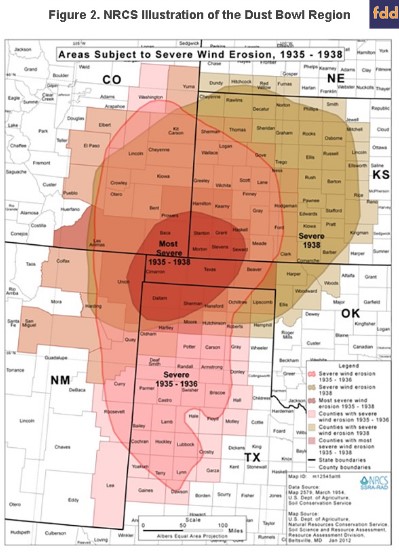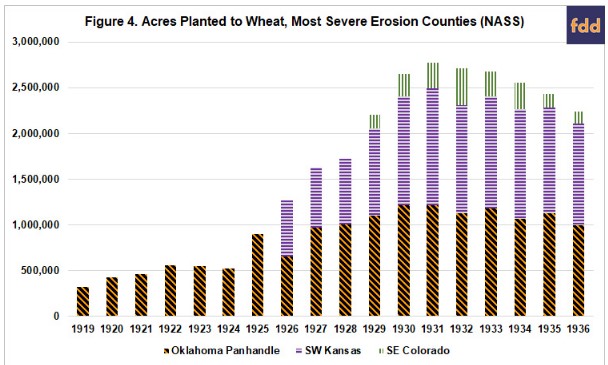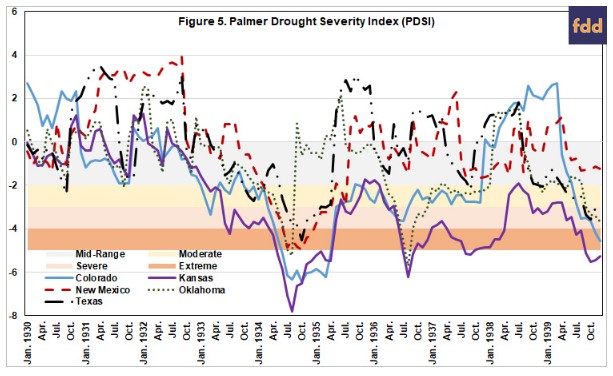By Jonathan Coppess
The images are indelible, captured in novels, history books, songs and old black-and-white photographs. During the mid-1930s, as Americans were trying to claw their way out of the depths of the Great Depression a severe drought triggered massive dust storms out of the plowed fields of the southern Great Plains. These storms carried topsoil east to the Atlantic Ocean, driving policy responses and changes in farming practices. The Dust Bowl is considered one of the worst environmental disasters in the Nation’s history; a confluence of policy, human activities, climatic shifts, and the outer bounds of nature’s tolerance. A potential historical analogue for the climate change discussion, it offers lessons for policies designed in response. Part two of the Conservation Question series, a discussion of federal farm conservation policy, focuses on the Dust Bowl (farmdoc daily October 17, 2019).
Background
The dust storms that would ravage the southern Great Plains and deposit the Dust Bowl into the annals of American history began in January 1932 with storms that were initially relatively contained (Hurt 1981). Dust storms became more common in 1933, first depositing dust in the Great Lakes that November and growing into a national concern beginning spring of 1934. A storm that began on May 9, 1934, would deposit 12 million pounds of Great Plains soil on Chicago and within days drop dust on cities along the eastern seaboard from Boston to Atlanta (Worster 2004). The following year, 1935, is remembered as the worst year for dust storms highlighted by a massive storm on Easter Sunday in mid-April that would proceed to darken the skies over Washington DC and spur Congress to action (Eagan 2006; Worster 2004; Hurt 1981).
The Dust Bowl can be understood as the collision of American agricultural expansion into the Great Plains (converting grasslands to intense crop production) with years of extreme drought conditions, accompanied by strong winds and high temperatures (Porter 2013). While encompassing most of the Great Plains geographical region, the Dust Bowl has largely applied to the southern portion, concentrated in the Oklahoma and Texas panhandles, southwestern Kansas, southeastern Colorado and northeastern New Mexico (Stephens 1937). This concentration is illustrated by the following map available from USDA’s Natural Resources Conservation Service (NRCS) (History of NRCS).

Much of the region is located west of the 20-inch annual rainfall line on the high plains east of the Rocky Mountains, a region prone to high winds and relatively frequent drought cycles where crop production was long understood to be hazardous. The peak of the Dust Bowl impacted about 100 million acres in this region (Egan 2006). The Soil Conservation Service concluded from surveys in 1934 that 65% of the Great Plains acreage had suffered wind erosion damage and that 15% was severely eroded; by 1938, it concluded that 80% of the southern Great Plains had been impacted by wind erosion, 40% seriously impacted (Hansen and Libecap 2004). A 1936 report produced for President Franklin Roosevelt by the Great Plains Committee concluded that approximately 15 million acres in the region should be taken out of production and returned to permanent grassland (GPC Report 1936).
Discussion: How to Build a Dust Bowl
The Dust Bowl formed part of a cultural and historical narrative coinciding as it did with the Great Depression and the vast New Deal reform effort as arguably the “worst man-made ecological disaster in American history” and considered a “morality tale about our relationship to the land that sustains” civilization (Burns 2012; Cunfer 2005). Building the Dust Bowl required a series of human actions that put the region on a collision course with natural forces. In short, the Dust Bowl combined policy, plowing and drought. Changes wrought by policy and the plow pushed the land beyond its natural limits and when the climate cycled back to drought the pulverized soils were left exposed to high winds.
(1) Step One: Settlement and Land Policy.
The Homestead Act of 1862 drove settlement on the Great Plains by providing free land of 160 acres or less for any U.S. citizen if they settled (occupied) and cultivated the land for five years; Congress increased the acreage to 320 acres with the Enlarged Homestead Act of 1909 (U.S. Senate 1961). Approximately 6 million people migrated to the plains by 1890; records indicate that 1.5 to 1.6 million homestead patents transferred between 248 million and 270 million acres of land from 1868 to 1960 (Edwards 2009; Worster 2004; Laycock 1988; U.S. Senate 1961). Giving away land held in the public domain under the Homestead Act was the ultimate accomplishment of what was known as the free land movement; reformers seeking to combat the accumulation of large landholding by monopolies, corporations, speculators and other large interests, as well as to provide poor people with some wealth out of the public domain in the form of land and home (Edwards 2009; Gates 1977).
Lofty ideals ran aground upon the climatic realities of the arid region west of the 100th meridian where precipitation was too little and too inconsistent to support traditional farming, especially on plots as small as 160 acres (Worster 2004; Stephens 1937). Although this had been understood at least since 1878, larger homesteads—John Wesley Powell proposed homesteading units of 2,560 acres (4 square miles)—were less politically beneficial because fewer people would have settled in the region to be represented in Congress; large homesteads were counter to the free land reformist view that small farms would serve as an antidote to land control by large interests (Edwards 2009; Worster 2004; Gates 1977). Ultimately, 160 acres proved simply too small to be a viable farm in this more arid (or semiarid) region, especially considering that the Homestead Act did not help poor people raise the capital necessary to survive, let alone succeed. Moreover, railroads and other large interests tended to grab the best lands, such as those nearest water sources, and accumulated large acreages; the entire undertaking was plagued by rampant speculation, persistent homestead failures, and fraud and abuse on both large and small scales (Edwards 2009; Gates 1977).
(2) Step Two: Break the Native Sod, Plow the Ground and Pulverize the Soil.
The Homestead Act of 1862 required that settlers cultivate their fields for five consecutive years in order to perfect their property right, although the 1909 Act reduced that requirement to three years (Worster 2004). The result was a massive plow-up—breaking the native sod of short grasses for farming—a view famously promoted by the Resettlement Administration (USDA)-sponsored film, “The Plow That Broke the Plains” written and directed by Pare Lorentz and released in 1936 (Cunfer 2005). Research indicates that 104 million acres of native sod were plowed under by homesteaders in the entire region between initial settlement in 1880 and 1900, 20 million by 1925 and 5 million more by 1930 (Egan 2006; Laycock 1988). Farmers in Kansas, Colorado, Nebraska, Oklahoma and Texas plowed 11 million acres by 1919 and roughly 40 million acres in the southern and portions of the central Great Plains by 1929, mostly for wheat (Worster 2004; Unger and Baumhardt 2001).
Figure 3 provides an excerpt of images from research by Geoffrey Cunfer that tracked the percentage of the total acres in Dust Bowl counties converted to cropland; counties in white have 90% or greater in native grassland, while dark brown counties are those with more than 60% in cropland (Cunfer 2005).
Figure 4 adds perspective to Figure 3. Figure 4 illustrates a sample of planted acreage data from the National Agricultural Statistics Service (NASS) in the counties contained in the most severe wind erosion (1935-1938) region of the NRCS map (Figure 2) for Oklahoma, Kansas and Colorado. Note that the NASS data are incomplete for the years at issue and that the counties in Texas are not included for lack of planted acres data.

The sheer number of acres put under plow was only part of the equation, however. It was the method of farming and, in particular, cultivation that magnified the impact of breaking the Plains. The farmers moving into the Great Plains had come from the Midwest, East Coast or Europe where rains were plentiful; farming experience, knowledge and practices were all based on a very different climate than the one to which they were moving (Libecap and Hansen 2002; Hargreaves 1977). Scientific research for farming was minimal, data on precipitation and weather was sparse and unreliable; USDA was slow to extend limited agricultural research and knowledge to the settlers rapidly plowing under the Plains (Hargreaves 1977; Hargreaves 1948). The Smith-Lever Act that created the extension service was passed in 1914, more than 30 years after settlers began plowing on the Great Plains (Coppess 2018).
The vacuum left by the lack of experience and scientific research was quickly filled by pseudo-scientific theories around a practice known as the dry (or dryland) farming method and propaganda from the railroads and other landholding interests seeking to promote settlement in the region (Libecap and Hansen, 2002; Hargreaves 1977; Hargreaves 1948). These efforts, in turn, were supported by folklore and mythmaking. The slogan that “rain follows the plow” encapsulated an unbridled optimism about westward expansion and human ingenuity to improve upon nature (Smith 1947). The result was that settlers in the Great Plains were advised to strictly adhere to intensive cultivation that pulverized the topsoil and was based on the theory that subsurface water would move upward through the soil to nourish plants if it were properly captured in a packed subsurface with a dust mulch above it.
(3) Step Three: Add War and Depression.
Pulverized soil in a wind-swept, semi-arid region by settlers with little experience or information and limited acreage for success was a recipe for disaster. That reckoning was put off by an economic boost from World War I, which began in 1914. The U.S. encouraged farmers to plant wheat to help win the war and farmers added tens of millions of acres of wheat (Coppess 2018; Worster 2004; Laycock 1988; Hurt 1981). Strong prices and government support fueled the sod-breaking trend that had been underway in the Plains for years. The end of free land policy helped build a gold-rush mentality; speculators and absentee landowners, known as suitcase farmers, proliferated.
Farmers continued planting wheat on those acres throughout the post-war years, however, creating a farm depression during the booming Twenties that preceded the 1929 crash and the Great Depression. The farm depression did not halt plowing and production because financially-stressed farmers tended to work the land harder (and expand acreage where possible) to try and make up for low prices; a self-defeating process in which individuals try to improve their financial situation but collectively make matters worse. The Great Depression made the situation more untenable and many farmers failed or walked away from the broken land, leaving behind barren, pulverized soils.
Step Four: Let Nature Take Over; Drought and Wind.
Beginning in 1931, a severe drought hit the Great Plains, considered the “drought of record” for the United States (National Drought mitigation Center, University of Nebraska). The 1930s drought had been preceded by a relatively long period of above normal preciptiation and favorable weather for the Great Plains; almost a trick of nature in that coincided with the tail end of homesteading, wartime demand and the significant expansion of production. Moreover, dust from wind-eroded fields is now understood to have contributed further to the drought, worsening its conditions in a feedback loop between natural cycles and the effects of human endeavors (Cordova and Porter 2015; McLeman et al. 2014; Cook et al. 2009).
Figure 5 illustrates the Palmer Drought Severity Index for the 1930s (PDSI) for the southern Plains states. The PDSI is a measurement of the duration and intensity of drought weather patterns. It is based on temperature and precipitation data to estimate a measure of dryness on an index that spans from -10 to 10; severe drought is at -3 and extreme drought at -4 on the index. Based on this measure, the worst of the drought was in 1934 and 1935, followed by latter half of 1936.

Look back to Figures 2 and 3, drought and wind erosion was concentrated in 208 counties in Colorado, Kansas, New Mexico, Oklahoma and Texas but it impacted the entire nation and carved out a place in history. These were the last places settled; expansion in the Oklahoma and Texas panhandles took place from 1925 to 1935. Yet, only about 15% of these counties lost more than 60% of their native grasslands and 42 counties retained more than half of their native sod; 15 counties had more than 80% of their acreage unbroken (Cunfer 2005). These counties were not spared the ravages of wind erosion. Unbroken ground lost vegetative cover to drought and, more importantly, was inundated by blowing soil so that it eventually lost topsoil as well.
Concluding Thoughts
The Dust Bowl presents a visceral historical analogue. It should counsel humility about the ability of humans to perpetually push natural resources for their benefit; written in the dust of the thirties are warnings aplenty. The Dust Bowl was triggered by an extreme drought—part of a natural cycle over which we had little knowledge and less control—but it had been built by policies and misguided actions in an unfamiliar environment. The dust storms highlighted how actions of individuals on their property impacted others, both nearby and across the nation, and could contribute to the unfolding environmental catastrophe. Broken sod and pulverized soils were extremely vulnerable to drought, high temperatures and strong winds; they did not stay in place. Fields abandoned by suitcase or bankrupt farmers overwhelmed the remaining grasslands that hadn’t been broken. Intensive cultivation by some farmers negated any efforts by other farmers to prevent soil erosion. To add to the lessons and perspectives, the next article in this series will explore the efforts to respond to, and recover from, the Dust Bowl.
Source : illinois.edu